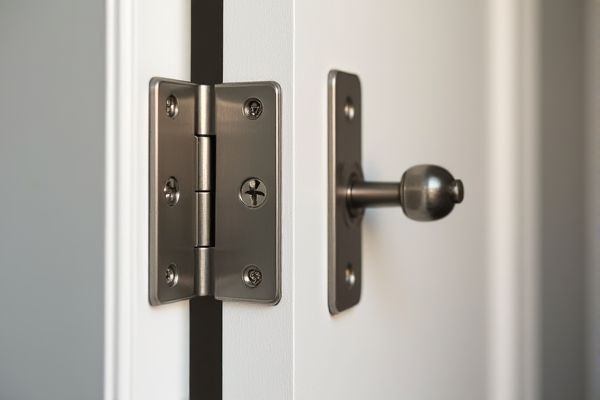
Soft-close hinges gently slow the door's movement to prevent slamming and reduce noise, enhancing your cabinet's durability and user experience. Explore the differences between soft-close and self-closing hinges to determine which option best suits your needs.
Table of Comparison
| Feature | Soft-Close Hinge | Self-Closing Hinge |
|---|---|---|
| Function | Slows door closing to prevent slamming | Automatically closes door from open position |
| Mechanism | Damping piston or hydraulic system | Spring-loaded mechanism |
| Use Case | Kitchen cabinets, furniture doors | Fire doors, access control doors |
| Closing Speed | Controlled, slow close | Automatic, varies by spring tension |
| Noise Reduction | Yes, minimizes noise | Minimal noise control |
| Installation | Requires precise alignment | Basic installation, less alignment |
| Cost | Higher cost due to damping system | Lower cost, simpler design |
| Maintenance | Low maintenance | May require spring replacement |
Introduction to Soft-Close and Self-Closing Hinges
Soft-close hinges use integrated dampers to gently slow door movement, preventing slamming and reducing wear. Self-closing hinges rely on springs or gravity to automatically pull doors shut without user effort, enhancing convenience and security. Both hinge types improve functionality but serve different purposes: soft-close hinges prioritize noise reduction and door protection, while self-closing hinges ensure doors close reliably for safety and energy efficiency.
What is a Soft-Close Hinge?
A soft-close hinge is designed to prevent cabinet doors from slamming shut by slowing the door's movement during the final closing phase, providing a quiet and smooth closure. It incorporates a damping mechanism, typically using hydraulic or piston technology, that gently controls the door's speed. This feature enhances durability by reducing wear and tear on both the door and frame, making soft-close hinges a popular choice in modern cabinetry.
What is a Self-Closing Hinge?
A self-closing hinge automatically returns a door or lid to a closed position without any manual effort, using spring tension or gravity. These hinges are commonly used in applications requiring doors to remain shut for safety or energy efficiency. Your choice of a self-closing hinge can enhance convenience and security by preventing doors from being accidentally left open.
Key Differences: Soft-Close vs Self-Closing Hinges
Soft-close hinges slow down the door's movement to prevent slamming, providing a quiet and smooth closure, whereas self-closing hinges automatically pull the door shut after it has been opened, ensuring it closes fully without manual effort. Soft-close hinges incorporate damping mechanisms to control the final part of the closing action, while self-closing hinges use springs or gravity to initiate the closing motion. The primary difference lies in soft-close hinges emphasizing gentle, noise-free closure, while self-closing hinges focus on ensuring the door closes completely and securely.
Mechanism: How Each Hinge Type Works
Soft-close hinges utilize a hydraulic damping mechanism that slows the door's movement during closing, preventing it from slamming shut and ensuring a gentle, quiet close. Self-closing hinges operate through a spring-loaded mechanism that automatically pulls the door closed after it has been opened beyond a certain angle, without controlling the speed of closure. Understanding these mechanisms helps you select the right hinge for applications requiring controlled, smooth closing versus automatic door closure functionality.
Pros and Cons of Soft-Close Hinges
Soft-close hinges offer the advantage of preventing doors from slamming, reducing noise and minimizing wear on cabinets, making them ideal for kitchens and bathrooms. However, these hinges tend to be more expensive and may require precise installation to function effectively, increasing upfront costs and complexity. In contrast, self-closing hinges automatically pull doors shut for convenience but lack the cushioning effect, potentially leading to noise and quicker hardware degradation.
Pros and Cons of Self-Closing Hinges
Self-closing hinges automatically shut doors after opening, improving energy efficiency and security by preventing doors from being left open. However, they can cause wear on doors and frames over time due to repetitive motion and may be noisy if not properly maintained. You should consider their maintenance needs and noise levels against their convenience when choosing between self-closing and soft-close hinges.
Applications: Where to Use Each Hinge Type
Soft-close hinges are ideal for residential cabinetry, bathroom vanities, and kitchen cupboards where noise reduction and smooth closing are priorities, preventing door slamming and enhancing user comfort. Self-closing hinges are commonly used in commercial settings, such as office doors, utility cabinets, and storage units, where ensuring the door automatically closes for security and energy efficiency is essential. You can choose soft-close hinges for quieter, controlled closing in everyday furniture, while self-closing hinges serve better in environments needing reliable automatic door closure.
Installation and Maintenance Considerations
Soft-close hinges require precise alignment during installation to ensure gradual, silent door closing and may need occasional lubrication to maintain smooth operation. Self-closing hinges feature simpler installation with built-in springs that automatically close the door, but springs can wear out over time, necessitating replacement for consistent functionality. Understanding your door's usage and maintenance routine will help you choose the hinge type that suits your needs best.
Which Hinge Should You Choose?
Soft-close hinges provide a controlled, silent closing mechanism that prevents cabinet doors from slamming, making them ideal for homes where noise reduction and door protection are priorities. Self-closing hinges automatically pull the door shut after it reaches a certain angle, offering convenience and ensuring doors are not left ajar, which works well in high-traffic or commercial settings. Your choice depends on whether you prioritize noise control and smooth operation with soft-close hinges or the automatic convenience and consistent closure of self-closing hinges.
 homyna.com
homyna.com